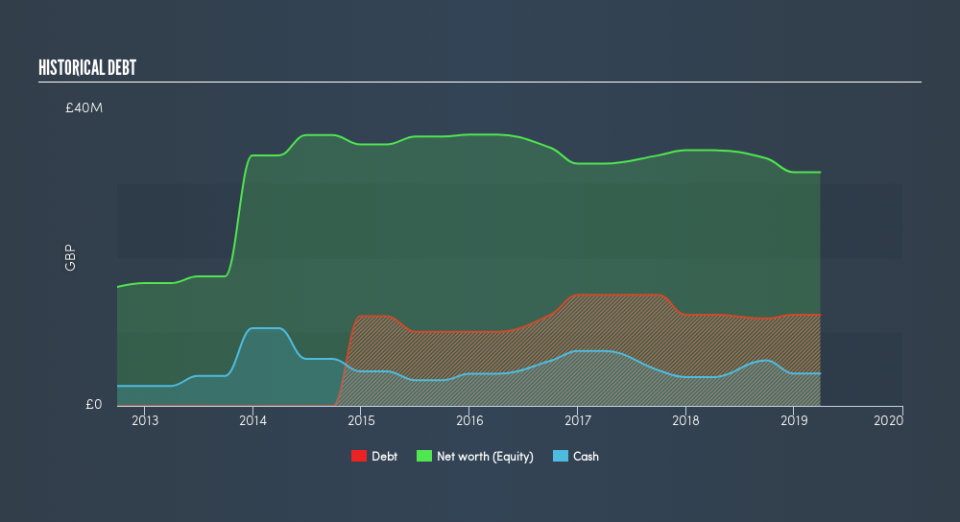We Think Pressure Technologies (LON:PRES) Has A Fair Chunk Of Debt

Some say volatility, rather than debt, is the best way to think about risk as an investor, but Warren Buffett famously said that 'Volatility is far from synonymous with risk.' It's only natural to consider a company's balance sheet when you examine how risky it is, since debt is often involved when a business collapses. Importantly, Pressure Technologies plc (LON:PRES) does carry debt. But the real question is whether this debt is making the company risky.
When Is Debt A Problem?
Debt and other liabilities become risky for a business when it cannot easily fulfill those obligations, either with free cash flow or by raising capital at an attractive price. Part and parcel of capitalism is the process of 'creative destruction' where failed businesses are mercilessly liquidated by their bankers. However, a more frequent (but still costly) occurrence is where a company must issue shares at bargain-basement prices, permanently diluting shareholders, just to shore up its balance sheet. By replacing dilution, though, debt can be an extremely good tool for businesses that need capital to invest in growth at high rates of return. When we examine debt levels, we first consider both cash and debt levels, together.
Check out our latest analysis for Pressure Technologies
What Is Pressure Technologies's Net Debt?
You can click the graphic below for the historical numbers, but it shows that Pressure Technologies had UK£12.3m of debt in March 2019, down from UK£13.2m, one year before. On the flip side, it has UK£4.36m in cash leading to net debt of about UK£7.94m.
How Healthy Is Pressure Technologies's Balance Sheet?
According to the last reported balance sheet, Pressure Technologies had liabilities of UK£6.76m due within 12 months, and liabilities of UK£15.0m due beyond 12 months. On the other hand, it had cash of UK£4.36m and UK£8.27m worth of receivables due within a year. So its liabilities total UK£9.12m more than the combination of its cash and short-term receivables.
While this might seem like a lot, it is not so bad since Pressure Technologies has a market capitalization of UK£19.7m, and so it could probably strengthen its balance sheet by raising capital if it needed to. However, it is still worthwhile taking a close look at its ability to pay off debt. The balance sheet is clearly the area to focus on when you are analysing debt. But it is future earnings, more than anything, that will determine Pressure Technologies's ability to maintain a healthy balance sheet going forward. So if you want to see what the professionals think, you might find this free report on analyst profit forecasts to be interesting.
In the last year Pressure Technologies managed to grow its revenue by 45%, to UK£38m. With any luck the company will be able to grow its way to profitability.
Caveat Emptor
Despite the top line growth, Pressure Technologies still had negative earnings before interest and tax (EBIT), over the last year. To be specific the EBIT loss came in at UK£632k. Considering that alongside the liabilities mentioned above does not give us much confidence that company should be using so much debt. Quite frankly we think the balance sheet is far from match-fit, although it could be improved with time. However, it doesn't help that it burned through UK£248k of cash over the last year. So to be blunt we think it is risky. When we look at a riskier company, we like to check how their profits (or losses) are trending over time. Today, we're providing readers this interactive graph showing how Pressure Technologies's profit, revenue, and operating cashflow have changed over the last few years.
If you're interested in investing in businesses that can grow profits without the burden of debt, then check out this free list of growing businesses that have net cash on the balance sheet.
We aim to bring you long-term focused research analysis driven by fundamental data. Note that our analysis may not factor in the latest price-sensitive company announcements or qualitative material.
If you spot an error that warrants correction, please contact the editor at editorial-team@simplywallst.com. This article by Simply Wall St is general in nature. It does not constitute a recommendation to buy or sell any stock, and does not take account of your objectives, or your financial situation. Simply Wall St has no position in the stocks mentioned. Thank you for reading.

